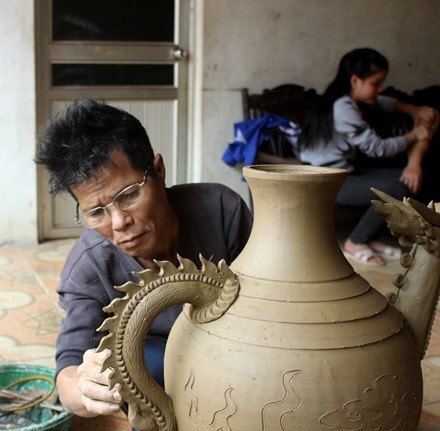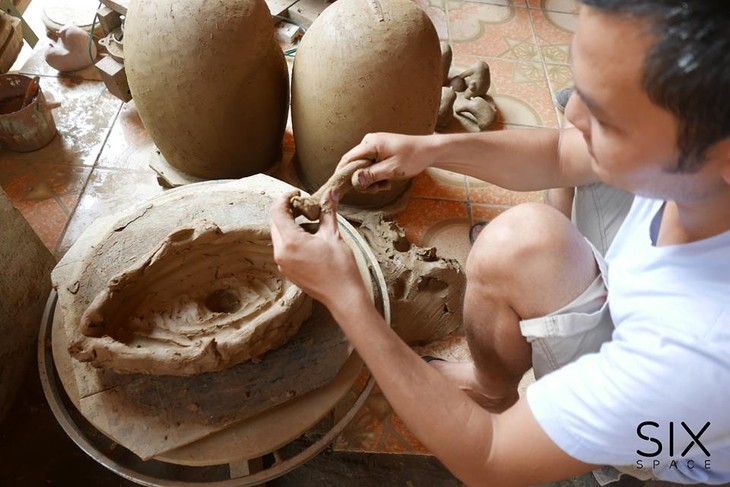Huong Canh pottery prices reflect the dedication of artisans preserving Vietnamese cultural heritage, and SIXT.VN ensures you experience this firsthand. Discover authentic ceramics and explore Vietnam with ease. To plan your visit, consider SIXT.VN for reliable transport and accommodations, ensuring a memorable journey exploring Vietnamese handicrafts and local artistry.
1. What Makes Huong Canh Pottery Unique?
Huong Canh pottery stands out because of its unique green clay, which turns a distinctive dark reddish-brown when fired. This clay shrinks significantly more than others, leading to stronger and more durable products. The pottery-making process is a testament to traditional Vietnamese craftsmanship, with techniques passed down through generations.
1.1. The Distinctive Green Clay
The green clay used in Huong Canh pottery is sourced locally from about 8 meters below ground. This clay’s special properties include a high shrinkage rate when heated, which, according to artisan Tran Van Hai, can be up to 26%, compared to about 13% in other Vietnamese pottery villages. This high shrinkage is due to a “fat element” in the clay, which disappears during firing, resulting in a tighter, more durable product.
1.2. Traditional Firing Techniques
Huong Canh pottery uses unique kiln designs with a one-way flame, requiring precise control over the firing process. Artisan Tran Van Hai explains that maintaining the correct temperature is crucial to avoid defects. The firing process takes about 36 hours, followed by two days of cooling. Temperatures are carefully managed, starting at 500 DC for 28 hours, then raised to 850 DC for six hours, and finally reaching 1200-1300 DC for the last two hours.
1.3. Absence of Glaze
Unlike many other types of pottery, Huong Canh pottery does not use glaze. According to Tran Ngoc Lam, the rustic color and rough surface are integral to the pottery’s authentic beauty. The high heat of the kiln melts and blends the clay, creating a natural shine without the need for artificial glazing.
2. What Factors Influence the Price of Huong Canh Pottery?
Several factors affect the prices of pottery items in Huong Canh, including the cost of materials, the complexity of the design, the artisan’s skill, and the time required to produce each piece. Demand also plays a significant role, with rare or highly sought-after items fetching higher prices.
2.1. Materials and Labor Costs
The cost of the unique green clay, sourced locally, is a primary factor in the pricing of Huong Canh pottery. The labor-intensive process, from digging the clay to firing the pottery, also contributes to the overall cost.
2.2. Complexity of Design
Intricately designed or larger items require more time and skill, thereby increasing their price. Simpler, more utilitarian pieces are generally more affordable.
2.3. Artisan’s Reputation
Pottery made by well-known artisans often commands a premium. The reputation of the artisan is a testament to their skill and the quality of their work, making their pieces more valuable.
2.4. Market Demand
As with any product, market demand influences prices. Unique or rare items, especially those popular among tourists and collectors, tend to be more expensive. According to Sculptor Thai Nhat Minh, HÆ°Æ¡ng Canh products are now sold well and at higher prices because not many villagers are making pottery.
3. What Are Examples Of Typical Pottery Items And Their Price Ranges?
Huong Canh offers a variety of pottery items, each with its own price range depending on size, complexity, and craftsmanship. Here are some examples:
3.1. Small Jars
Small jars, traditionally used for making pickles, are among the most popular and affordable items.
- Price Range: $5 – $15
3.2. Cooking Pots
Cooking pots are durable and practical, reflecting the rustic nature of Huong Canh pottery.
- Price Range: $10 – $30
3.3. Decorative Vases
Decorative vases showcase the unique dark reddish-brown color of the fired clay and are popular souvenirs.
- Price Range: $15 – $40
3.4. Large Storage Jars
Large storage jars, known for their durability and ability to preserve contents, are the most expensive items.
- Price Range: $50 – $150+
4. How Does The Price Of Huong Canh Pottery Compare To Other Vietnamese Pottery?
Huong Canh pottery often commands higher prices than other Vietnamese pottery due to its unique clay and labor-intensive production methods. The pottery’s durability and cultural significance contribute to its value.
4.1. Unique Clay and Production
The distinctive green clay and the specialized firing techniques contribute to the higher price point of Huong Canh pottery. As artisan Tran Van Hai noted, the precise kiln dimensions and temperature control required for Huong Canh pottery make the production process more challenging and costly.
4.2. Durability and Quality
The enhanced durability resulting from the unique clay and firing process ensures that Huong Canh pottery stands the test of time. This longevity, combined with the pottery’s ability to preserve contents effectively, justifies the higher price compared to other pottery types.
4.3. Cultural Significance
The cultural heritage associated with Huong Canh pottery adds to its value. Its historical significance and traditional craftsmanship make it a sought-after item for collectors and tourists alike.
5. Where Can You Buy Authentic Huong Canh Pottery?
Authentic Huong Canh pottery can be purchased directly from the village in Vinh Phuc province, ensuring you get genuine products and support local artisans. Online platforms and craft shops in major cities like Hanoi also offer Huong Canh pottery.
5.1. Visiting Huong Canh Village
The best way to ensure authenticity is to visit Huong Canh village. Here, you can buy directly from the artisans, see the pottery-making process, and learn about the history and techniques involved.
5.2. Online Platforms
Several online platforms specialize in Vietnamese handicrafts, offering a range of Huong Canh pottery. Ensure the sellers are reputable and can provide proof of authenticity.
5.3. Craft Shops in Hanoi
Hanoi’s craft shops often feature pottery from various regions, including Huong Canh. These shops carefully select their products, ensuring quality and authenticity.
6. What Are The Key Features To Look For When Buying Authentic Huong Canh Pottery?
When buying Huong Canh pottery, look for the distinctive dark reddish-brown color, the absence of glaze, and the rustic texture. Authentic pieces should also be durable and well-made, reflecting the traditional craftsmanship of the region.
6.1. Color and Texture
Authentic Huong Canh pottery has a unique dark reddish-brown color and a rough, unglazed texture. According to Tran Ngoc Lam, any pottery product with glaze is not made by Huong Canh villagers.
6.2. Durability
Huong Canh pottery is known for its durability. Check for sturdiness and resistance to breakage, ensuring the piece will last for years.
6.3. Craftsmanship
Examine the pottery for signs of careful craftsmanship. Well-made pieces will have even surfaces, consistent thickness, and no visible defects.
7. What Are The Common Uses For Huong Canh Pottery?
Huong Canh pottery is commonly used for cooking, storage, and decoration. Its durability and unique properties make it ideal for preserving food, cooking traditional dishes, and adding a rustic touch to home décor.
7.1. Cooking
The pottery’s ability to withstand high temperatures makes it perfect for cooking traditional Vietnamese dishes. The even heat distribution ensures food is cooked thoroughly and evenly.
7.2. Storage
Huong Canh pottery is excellent for storing food items like pickles, grains, and liquids. Its ability to block out light and moisture helps preserve the contents for extended periods.
7.3. Decoration
The rustic and unique appearance of Huong Canh pottery makes it a popular choice for home décor. Vases, pots, and other decorative items add a touch of Vietnamese culture to any space.
8. How Has Tourism Affected The Price And Availability Of Huong Canh Pottery?
Tourism has increased the demand for Huong Canh pottery, leading to higher prices and greater availability. While this has benefited local artisans, it has also raised concerns about authenticity and the preservation of traditional techniques.
8.1. Increased Demand
The influx of tourists has driven up demand for Huong Canh pottery, allowing artisans to sell more products and earn higher incomes.
8.2. Higher Prices
Increased demand has led to higher prices, making it more expensive for both tourists and locals to purchase Huong Canh pottery.
8.3. Authenticity Concerns
The popularity of Huong Canh pottery has led to the production of imitation products, raising concerns about authenticity. Tourists should be cautious and buy from reputable sources to ensure they are getting genuine Huong Canh pottery.
9. What Are The Travel Considerations When Visiting Huong Canh Village To Purchase Pottery?
When planning a trip to Huong Canh village to purchase pottery, consider transportation, accommodation, and the best time to visit. Understanding the local culture and customs will enhance your experience.
9.1. Transportation
Huong Canh village is located in Vinh Phuc province, near Hanoi. You can hire a car or take a bus from Hanoi to Vinh Phuc, and then travel to the village. SIXT.VN offers convenient and reliable transportation options for traveling from Hanoi to Vinh Phuc, ensuring a comfortable journey.
9.2. Accommodation
While Huong Canh village is a small, rural area, there are accommodations available in nearby towns. Consider staying in Vinh Phuc city for a range of hotel options. SIXT.VN can assist with booking accommodations that suit your preferences and budget.
9.3. Best Time to Visit
The best time to visit Huong Canh village is during the dry season (October to April) when the weather is pleasant and ideal for exploring the pottery-making process.
9.4. Cultural Etiquette
Respect the local culture by dressing modestly and being mindful of the artisans’ working environment. Engaging with the locals respectfully will enrich your experience and provide insights into their craft.
10. What Future Trends Do Experts Predict For The Huong Canh Pottery Market?
Experts predict that the Huong Canh pottery market will see continued growth, driven by tourism and a renewed interest in traditional crafts. Innovations in design and marketing will help the pottery appeal to a broader audience while preserving its cultural heritage.
10.1. Continued Growth
The market for Huong Canh pottery is expected to grow as more tourists visit the region and discover the unique beauty and durability of the pottery.
10.2. Design Innovations
Artisans are likely to experiment with new designs and techniques to appeal to contemporary tastes while maintaining the traditional essence of Huong Canh pottery.
10.3. Marketing Strategies
Effective marketing strategies, including online promotion and collaborations with tourism agencies, will help raise awareness of Huong Canh pottery and attract more customers.
10.4. Preservation of Heritage
Efforts to preserve the traditional techniques and cultural significance of Huong Canh pottery will ensure that this unique craft continues to thrive for generations to come.
Visiting Huong Canh offers a unique glimpse into Vietnam’s rich cultural heritage. By understanding the factors influencing the price of Huong Canh pottery, you can make informed purchasing decisions and appreciate the artistry behind each piece. Let SIXT.VN help you plan your trip with reliable transport and comfortable accommodations, ensuring a memorable and enriching experience.
Ready to explore the cultural treasures of Vietnam? Visit SIXT.VN today to book your transportation, accommodation, and tours!
FAQ about Huong Canh Pottery
1. What is Huong Canh pottery known for?
Huong Canh pottery is known for its unique green clay that turns dark reddish-brown when fired, exceptional durability, and traditional craftsmanship.
2. How can I identify authentic Huong Canh pottery?
Look for the distinctive dark reddish-brown color, unglazed surface, and rustic texture. Authentic pieces are also durable and well-crafted.
3. What are the typical uses for Huong Canh pottery?
It is commonly used for cooking, storing food (like pickles), and as decorative items due to its durability and unique properties.
4. Why is Huong Canh pottery more expensive than other Vietnamese pottery?
The unique clay, labor-intensive production methods, high durability, and cultural significance contribute to its higher price.
5. Where can I buy authentic Huong Canh pottery?
You can buy directly from artisans in Huong Canh village, from reputable online platforms, or at craft shops in Hanoi.
6. What factors influence the price of Huong Canh pottery?
Material costs, design complexity, artisan reputation, and market demand all affect the price.
7. How has tourism affected the price and availability of Huong Canh pottery?
Tourism has increased demand and prices but has also raised concerns about authenticity and preserving traditional techniques.
8. What should I consider when visiting Huong Canh village to buy pottery?
Consider transportation, accommodation, the best time to visit (dry season), and respecting local culture and customs.
9. Are there accommodations available near Huong Canh village?
While Huong Canh is rural, accommodations are available in nearby Vinh Phuc city, offering a range of hotel options.
10. What are the future trends predicted for the Huong Canh pottery market?
Experts predict continued growth, design innovations, effective marketing strategies, and efforts to preserve its cultural heritage.
 Huong Canh pottery products are made from the typical local clay of green color, which turns into dark reddish brown under high temperatures
Huong Canh pottery products are made from the typical local clay of green color, which turns into dark reddish brown under high temperatures
 The rustic pottery art of Huong Canh – ảnh 2
The rustic pottery art of Huong Canh – ảnh 2




